Foreign influences?
Roman horses
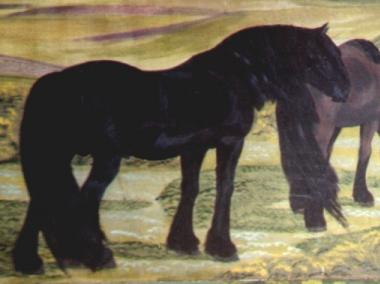 Archaeologists have posited at various
times over the past century that there were several types of horses in
use in Northern Britain in Roman times. Excavations on the site of the
Roman fort at Newstead, near Melrose (J
C Ewart, 1911), yielded a pony under 11 hands; a larger 12 hand
type, possibly the size of the wild pony of northern England; a 12 to
13 hand pony with slender bones; a thickset, long backed animal which
Ewart called a "lowland" type; and a horse of about 14 hands, possibly
an imported horse type used by Spanish, French or Hungarian troops.
There was also a 15 hand animal that was, again, probably imported
from the Continent (Edwards),
possibly from Frisia where there were merchant traders whose ships
could carry horses. Mules, which are a generally-infertile donkey x
horse hybrid, were also in use.
Archaeologists have posited at various
times over the past century that there were several types of horses in
use in Northern Britain in Roman times. Excavations on the site of the
Roman fort at Newstead, near Melrose (J
C Ewart, 1911), yielded a pony under 11 hands; a larger 12 hand
type, possibly the size of the wild pony of northern England; a 12 to
13 hand pony with slender bones; a thickset, long backed animal which
Ewart called a "lowland" type; and a horse of about 14 hands, possibly
an imported horse type used by Spanish, French or Hungarian troops.
There was also a 15 hand animal that was, again, probably imported
from the Continent (Edwards),
possibly from Frisia where there were merchant traders whose ships
could carry horses. Mules, which are a generally-infertile donkey x
horse hybrid, were also in use.
We don't know much about these animals. Although various pony authorities propose that the native British stock were dark-coated, we don't actually know what colour they were. Stone sculptures and bronze toys give no indications of colour.
Collected bone evidence from Southern England mainly points to small ponies in domestic use from the late Iron Age through to early medieval times.
Literary Comments: Tacitus
Tacitus, the Roman historian, wrote scathingly in 55 AD about the Germans and their equestrian battle maneouvres. He evidently admired light, speedy, handy horses more than the heavier animals of northern Europe: "Their horses are remarkable neither for beauty nor for fleetness. Nor are they taught various evolutions after our fashion, but are driven straight forward, or so as to make one wheel to the right in such a compact body that none is left behind another." (Tacitus, Germania)
Literary Comments: Julius Caesar
Caesar, the Roman general, who brought his troops into Southern Britain in 55 and 54 BC, did not discuss the size of the animals he saw in the British battle chariots, but he described the handiness of the charioteers with some admiration:
"they display in battle the speed of horse (cavalry), [together with] the firmness of infantry; and by daily practice and exercise attain to such expertness that they are accustomed, even on a declining and steep place, to check their horses at full speed, and manage and turn them in an instant and run along the pole, and stand on the yoke, and thence betake themselves with the greatest celerity to their chariots again."
A modern misconception
A common misconception is to link the Fell, Friesian and other mainly-black breeds (eg, Merens/Ariegeois, Døle, Pottok, Asturcon, Garrano and Bardigiano) by their modern appearance alone - ie, black colour and length of hair - and to imply that the Friesian is the only foreign input the Fell breed has had. The issue is by no means so clear-cut. Many areas other than Frisia contributed auxiliaries to the Roman Army in the North of England; such as France, Belgium, Spain, Hungary and Germany; for more details see the Cavalry page. Some of these countries practised gelding, so male war horses would not necessarily have been breeding material.
A Fell should not be described as a mini version of any other breed. In particular, the use of the term "mini-Friesian" is frowned upon by enthusiasts of the Fell pony and the Friesian alike.
Changes to Fell and Friesian breeds
Both Fells and Friesians have changed physically. (see Type page for a fuller discussion of the Fell's conformation). The Friesian of today is more upheaded and showy than even its recent predecessors. Its preferred modern shape is taller and lighter than its earlier recorded type.
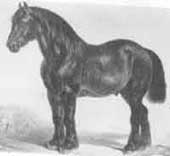 Another problem is the
possibility of confusion between the "Flemish" horse and the
"Friesian" horse both of which originated from North West Europe.
Flemish horses were black, strong, and useful to carry heavily
armoured knights. Friesian horses were mostly black, strong,
and useful etcetera...
Another problem is the
possibility of confusion between the "Flemish" horse and the
"Friesian" horse both of which originated from North West Europe.
Flemish horses were black, strong, and useful to carry heavily
armoured knights. Friesian horses were mostly black, strong,
and useful etcetera...
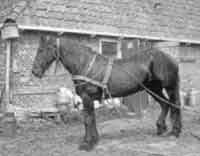
"During the 16th and 17th centuries, but probably also earlier, Arabian blood was introduced, especially through Andalusian horses from Spain. This has given them the high knee-action, the small head and the craning neck." (Bouma, 1979).
Whatever breeds were used, this crossing introduced desirable lighter riding qualities into what had previously been more of a heavy-armour or work horse.
For a timeline please see the Friesian Horse Association's web site where you can also read a short history from G. J. A. Bouma's “Het Friese Paard” from which the above quotation is taken.
Colour comparisons
It is the modern Friesian that has become almost exclusively "a black horse". Both the Fell and the Friesian originally varied much more in colour than they do now. The Friesian was not always an entirely black breed. Once, roans were permitted, and up to the end of the 19th century about twenty percent were chestnut or bay; these colours were deliberately eliminated (or blacks were "carefully selected", depending on your point of view).
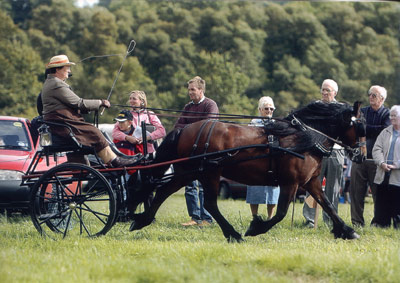
Fells have always been described as brown, bay, black or grey, but other colours have been registered in the early days of the Stud Book though they are not now seen in registered stock. It may be more significant for our equine argument that the colour black is easily bred "pure" to exclude other colours if fashion so dictates.
Brown Fells, for instance, dropped steadily out of favour on the show circuit from the 1950s onward, and even now many fewer browns/bays are registered than blacks. The result is that the modern (and mistaken) concept of the Fell, even in England, even in sometimes Cumbria, is "a black pony". Yet I have ridden or driven more bay and brown Fells (see photo of my excellent driving mare) than blacks!
"Roman" mystery
Surprisingly little is known of Roman military sources of horses (Hyland), so, until the conservators of the Vindolanda tablets decipher a Roman military stud list, we can only deduce the types of horses in the Fell’s homeland from the bones recorded in archaeological digs. Remember that the modern idea of a "breed" was a concept unknown in ancient times, and that what we're really talking about is a type of animal from a particular location.
Richardson (1990) remarks on the prepotence of the Friesian horse, while Dent and Machin-Goodall (1962) give evidence of the similarities of the Frisian language with Old English which is supported by DNA testing of people in more recent times (albeit from the southeast Danelaw area rather than from northwest England).
We may safely assume that there were some horses from Frisia among the Roman army lines because there were some 500 Frisian auxiliaries deployed at various times and locations within reach of Hadrian's Wall; but we must not forget that there were thousands of other foreign troops in northern Britain, including 1,000 French cavalry based at Stanwix, Carlisle.
I have several correspondents who hold that the Roman Sarmatian cavalrymen based at Ribchester were involved in horsebreeding for the Army in the North. Very large numbers of Sarmatian cavalry were moved around the North of England and Southern Scotland over several centuries, so at a stretch it might be possible to cite Ukrainian, Polish, Hungarian, or even Iranian horses as the source of any supposed outcross in our local breed. However Strabo, writing around the time of the birth of Christ, reported that the Sarmatians gelded their war horses (Hyland). Whether this custom became less universal among the Sarmatians in the 200 years that followed, cannot be certainly known (the Pazyryk burials included geldings, but those were of Scythian, not Sarmatian origin).
We actually know nothing specific about whether there were any breeding programmes, any long-sustained crosses, what types might have been involved or what locations they came from, the numbers that were bred, how many crossbred horses might have been kept as breeding or working stock, or how many offspring survived to produce further generations. There is no particular reason to suppose that ancient Roman horse imports could have much influence on the modern Fell after 2,000 years. So again, we simply don't know what foreign input there was.
Other dark, stocky European breeds of pony
It is equally possible that there were dark coated ponies all over Britain and Western Europe from which several rather similarly dark modern breeds descend, such as the Merens/Ariegeois, Døle, Pottok, Asturcon, Garrano and Bardigiano as well as the Fell and Dale.
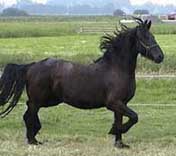 Who is to say that all these "black breeds" don't just
originate from a similar, very ancient stem? One would not be the
"ancestor" of any of the others - they would all be descendants from
one ancient stock.
Who is to say that all these "black breeds" don't just
originate from a similar, very ancient stem? One would not be the
"ancestor" of any of the others - they would all be descendants from
one ancient stock.
In that case, one has to assume that the Roman Army's auxilia, and their military preferences, must either have had little or no effect on any of our contemporary types, or must have affected all of them to roughly the same extent. I personally doubt that the Friesian is the fons et origo of these breeds. More likely they (including the Friesian) all derive from a common root; but it is a "chicken and egg" argument that could keep zooarchaeologists, DNA researchers and horse enthusiasts happily arguing for many years to come.
As an example: According to Jansen & Thomas's mitochondrial DNA study of 652 horse mtDNA sequences, the Fell is most closely related to another ancient British breed, the Exmoor pony (Jansen, Thomas et al. (2002) Proc. Natl. Acad. Sci. USA 99, 10905-10910). Shown diagrammatically, the Exmoor is close to the point of origin of all breeds, "the root of the network according to equid outgroups," and it occupies a branch of its own - separate from a dozen or so other branches. From the Exmoor's position in the diagram, one branch leads to the Fell, and others lead to the Fjord, the modern Thoroughbred, and the Rhineland Draft horse.
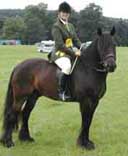 An even simpler theory about the number of mainly black
coated pony breeds is that they are a modern result of selective
breeding within a registered stock. This is undeniably the case with
the modern Friesian.
An even simpler theory about the number of mainly black
coated pony breeds is that they are a modern result of selective
breeding within a registered stock. This is undeniably the case with
the modern Friesian.
The temptation, however, in relation to the background of the Fell pony, is to use "the Romans" because they make good modern advertising copy. Complicated alternative possibilities do not.
It is very easy to offer a "black, and no white" nugget of "Roman history" that puts up a hypothesis in support of the despised but commercially useful phrase, "mini Friesian". It is difficult to capture popular interest with a more balanced view, and all the confusing shades of grey that this involves.
To the untutored eye, some present day Fells can appear superficially similar to some present day Friesians - but then, I have even been asked if a black Shetland was a Fell pony! The same mix-up can happen with other stocky breeds if the animals in question happen to be black.
Summary
"The Fell Pony Society wishes to state that it strongly disapproves of the use of comparisons with other breeds to describe, promote or advertise the Fell. A Fell pony is a Fell pony, a strong, hardy, versatile, purebred English working pony, who should not be described as a mini version of any other breed." So please, don't do it!
A black coat and a long mane and tail are not evidence that a modern equine descends from a breed that didn't exist way back in history. An occasional modern likeness cannot prove, on its own, that any two breeds looked the same in Roman times, nor that they were interbred.
In fact, history is silent on the subject.